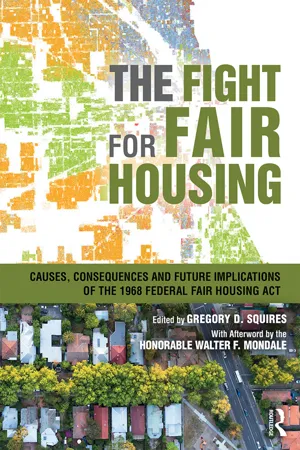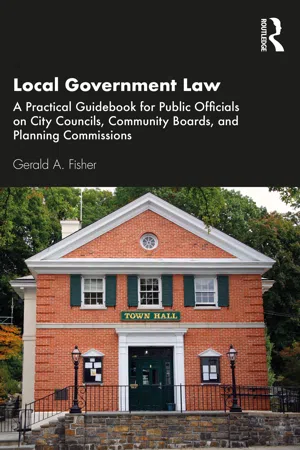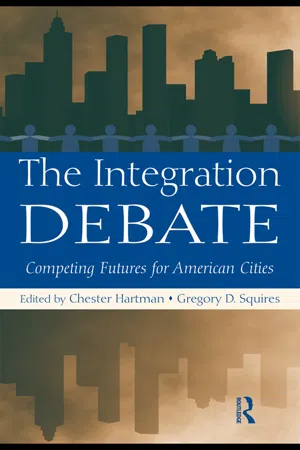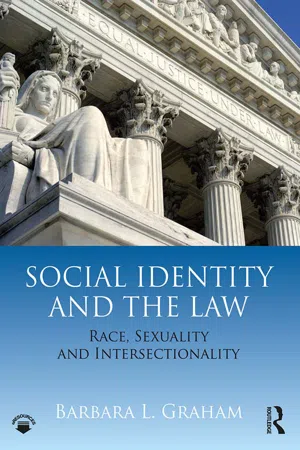History
Fair Housing Act 1968
The Fair Housing Act of 1968 is a landmark federal law in the United States that prohibits discrimination in the sale, rental, and financing of housing based on race, color, religion, sex, or national origin. It was enacted as part of the Civil Rights Act and aimed to address housing discrimination and segregation, promoting fair and equal access to housing opportunities for all.
Written by Perlego with AI-assistance
Related key terms
7 Key excerpts on "Fair Housing Act 1968"
- eBook - ePub
The Fight for Fair Housing
Causes, Consequences, and Future Implications of the 1968 Federal Fair Housing Act
- Gregory D. Squires(Author)
- 2017(Publication Date)
- Routledge(Publisher)
(Remarks on Signing the Civil Rights Act, Lyndon B. Johnson, April 11, 1968)With that, the Civil Rights Act of 1968 officially became the law of the land.The Fair Housing Amendments Act
While the passage of the Fair Housing Act was an undeniable civil rights victory, the true cost of the Dirksen Compromise would soon become clear. Without any significant enforcement power, HUD was incapable of doing anything other than attempting to reach a voluntary conciliation between parties. Private lawsuits and a small number of pattern-or-practice cases brought by the DOJ were not able to fill the void left by the lack of an administrative enforcement mechanism. Enforcement of state and local fair housing laws was spotty: whether or not the laws were enforced in a particular jurisdiction often depended upon whether any committed, experienced lawyers were willing to bring cases.As a result, in the decades to follow, the FHA would fail to live up to its promise to end housing discrimination and foster integrated living patterns. Residential segregation rates remained unacceptably high throughout the 1980s, a situation which scholars likened to apartheid. A 1979 national study by HUD found that housing discrimination was still pervasive. The study estimated that two million acts of housing discrimination took place each year (in contrast with just 5,000 complaints filed annually). It also found the probability of a black homeseeker experiencing discrimination was approximately 75 percent in the rental market and 62 percent in the sales market (Wienk et al. 1979: 64). As one commentator later noted, “Of all the civil rights battles fought during the last three decades, only housing discrimination appears to remain totally unabated, entrenched, and impervious to public policy and civil rights enforcement” (Kushner 1989: 1050).The coverage of the FHA remained an issue as well. The law included only race, color, religion, and national origin as protected characteristics. As the ensuing years would show, other categories of people were also in need of civil rights protections in housing. - eBook - ePub
Local Government Law
A Practical Guidebook for Public Officials on City Councils, Community Boards, and Planning Commissions
- Gerald A. Fisher(Author)
- 2021(Publication Date)
- Routledge(Publisher)
Chapter 7Fair HousingProviding access to decent housing for all, free of discrimination, has long been an important objective in the United States, an objective that has escaped full realization in spite of considerable attention.Traditionally, for purposes of providing an adequate assurance of lawful and decent housing, communities often understood this to involve local government enforcement of zoning and construction code regulations. While such enforcement continues to be relevant, it has become well-recognized that lawful and decent housing requires more comprehensive action in order to resolve the problem of housing segregation that remains in our country. Perhaps the most pervasive additional effort at addressing this issue is embodied in a federal law known as the Federal Fair Housing Act (42 U.S.C. 3601 et seq.) which broadly declared in 1968 that it is “the policy of the United States to provide, within constitutional limitations, for fair housing throughout the United States.” In 1988, the Fair Housing Amendments Act expanded its protections.The Federal Fair Housing Act (or “FHA”) will be the focus of this chapter. The discussion will first consider an historical context, focused on the first half of the 1900s, when the problem of housing segregation took a turn for the worse during the two World Wars, as well as the period after World War II, when the problem was exacerbated as metropolitan areas were created throughout the country. We will then focus on three specific areas of activity in which local governments can become targets for legal action under FHA regulations, thus making the FHA relevant to local officials. The discussion will finally turn to a review of court decisions which discuss the manner in which claims are made against local governments, and reviewed by the courts, under the FHA. - eBook - ePub
The Integration Debate
Competing Futures For American Cities
- Chester Hartman, Gregory Squires(Authors)
- 2009(Publication Date)
- Routledge(Publisher)
All citizens of the United States shall have the same right, in every State and Territory, as is enjoyed by white citizens thereof to inherit, purchase, lease, sell, hold and convey real and personal property. (42 U.S.C. § 1982)The promises of equal housing opportunities made in 1866 had yet to be realized2 by 1966, so Senators Walter Mondale (D-MN) and Edward Brooke (R-MA) introduced fair housing legislation. Mondale and Brooke draft ed legislation that went beyond other civil rights laws to include provisions for residential racial integration, but it failed to pass until April of 1968, in response after King’s assassination. The Fair Housing Act articulated two goals: to eliminate housing discrimination through enforcement of the law, and to intentionally promote residential integration. A strong enforcement provision was included, but was stripped from the bill by Senator Everett Dirksen (R-IL). Congress placed authority for enforcement of the Fair Housing Act in the newly created U.S. Department of Housing and Urban Development (HUD).The first mandate of the law—to eliminate housing discrimination through effective enforcement—was never realized by the government. The law allowed HUD only to “determine to resolve” or “determine not to resolve” a complaint after an investigation. If HUD determined to resolve a complaint, all it could do was ask the respondent if she or he wanted to attempt conciliation. If the respondent refused to conciliate or conciliation failed, HUD had to close the case. For the complainant, the only option for enforcement was to file his or her own lawsuit in federal district court.From 1968 to 1988, any effective enforcement of the Fair Housing Act was achieved primarily through individuals filing such lawsuits, private nonprofit fair housing agencies and testers filing as plaintiffs, or the Department of Justice bringing “pattern or practice” suits. Even though HUD’s enforcement mechanism was impotent, the statute itself was carefully crafted and given broad interpretation by the courts across the country, including the U.S. Supreme Court. As a result, private, nonprofit fair housing agencies vigorously investigated and tested rental, sales, lending, and homeowners’ insurance complaints, and fair housing groups and others filed federal and state lawsuits against individual landlords, apartment owners, real estate companies, banks and mortgage lenders, and homeowners’ insurance com-panies.3 During this period, many of the real estate sales lawsuits addressed the impact of racial steering4 on perpetuating residential segregation and stigmatizing neighborhoods. Plaintiffs used both the Fair Housing Act and the Civil Rights Act of 1866 to sue because the 1968 Fair Housing Act set a limit of $1,000 in punitive damages, while the Civil Rights Act of 1866 had no such limitations. The availability of punitive damages plays a critical role in persuading rental, real estate sales companies, and other housing-related businesses to comply with the Fair Housing Act. Actual damages can be less than $2,000 for many plaintiffs involved in rental discrimination cases, and compensatory damages awarded for embarrassment, humiliation, pain, and suffering oftendo not reflect the real injury suffered. With the risk of being caught and severely punished for violating the Fair Housing Act so minimal,5 - eBook - ePub
Staying Put
Adapting the Places Instead of the People
- Susan Lanspery, Joan Hyde(Authors)
- 2018(Publication Date)
- Routledge(Publisher)
Sandra J. Newman and Molli N. MezrichThe Fair Housing Act1 passed by Congress in September 1988 is a significant piece of legislation for individuals with functional impairments, including the frail elderly. Until passage of this Act, physically or mentally impaired individuals were excluded from explicit coverage by the housing discrimination provisions of Title VIII of the Civil Rights Act of 1968.2 These provisions pertain to the sale or rental of a dwelling as well as a range of other real estate transactions (e.g., financing, building, appraising). The new Fair Housing legislation adds people with disabilities as a “protected class” and extends to them the principle of equal housing opportunity. With respect to this book’s focus on housing modifications, the Act is also “by far the most far-reaching legislation encouraging accessible housing” [1 , p. 7 ]. Summarizing elements important to our discussion, two other analysts have noted:• The amendments to the Fair Housing law guaranteed the right to make home modifications in multi-family housing. This removed a legal barrier to serving the needs of low-income individuals [2 , p. vi ].• In the case of handicap or disability, discrimination includes a refusal to permit reasonable modifications to the premises, or to make reasonable accommodations in rules and procedures, to allow the tenant equal access to and enjoyment of the housing [3 , p. 10 ].In addition, the 1988 amendments restructure the enforcement provisions in a way that gives greater enforcement power both to the federal government and to private individuals.This chapter reviews the potential effects of the Fair Housing Amendments Act of 1988 on the frail elderly—that is, elderly individuals who need assistance in carrying out the normal activities of daily living. Definitions and applications related to the statute continue to evolve as case law accumulates, but we are still in the early stages of anticipating its ultimate effects [3 , 4 , 5 - eBook - ePub
- Steven W. Bender, Raquel Aldana, Gilbert Paul Carrasco, Joaquin G. Avila(Authors)
- 2015(Publication Date)
- Routledge(Publisher)
3 Discrimination in Housing Landlord DiscriminationAlthough the purchase of housing will also be discussed to some extent in this chapter, the focus will be primarily on the rental of housing. Latino/as are more likely than others to have the following characteristics associated with lower home-ownership rates:• householder is not a citizen; • householder is foreign-born; • foreign-born householder recently arrived in the United States; • young householder; • low income; • low educational attainment level; • residence located in central city; • residence in multifamily housing unit;• residence in high-cost housing market.1Many of the cases discussed in this chapter relate to African Americans, but a study conducted by the U.S. Department of Housing and Urban Development (HUD) reveals that discrimination against Hispanic renters has become more common than discrimination against African Americans.2The Civil Rights Act of 1964, although fairly comprehensive, did not prohibit private discrimination in housing. The need for such a provision became clear to Congress, however, in subsequent years, especially as young African Americans and Latino/as returned from fighting in Vietnam only to be denied housing because of their race. The assassination of Dr. Martin Luther King Jr. on April 4, 1968, helped spur Congress into action, and the Civil Rights Act of 1968 was enacted a week later. As amended, Title VIII (8) of the 1968 law, also known as the Fair Housing Act (FHA), prohibits discrimination in housing based on race, color, national origin, and familial status, among other categories.At about the same time Congress enacted Title VIII, the Supreme Court revived a federal remedy for violations of the housing discrimination provision of the post–Civil War Civil Rights Act of 1866, 42 U.S.C. § 1982 (Jones v. Alfred H. Mayer Co - eBook - ePub
Social Identity and the Law
Race, Sexuality and Intersectionality
- Barbara L. Graham(Author)
- 2018(Publication Date)
- Routledge(Publisher)
The Fair Housing Act does not create disparate-impact liability, nor do this Court’s precedents. And today’s decision will have unfortunate consequences for local government, private enterprise, and those living in poverty. Something has gone badly awry when a city can’t even make slumlords kill rats without fear of a lawsuit. Because Congress did not authorize any of this, I respectfully dissent.Barriers to Fair Housing
Persons of color have been confronted with a long history of residential housing segregation in the United States. What accounts for patterns of racial segregation is complex, but a recent study of the history of housing segregation in America reveals how laws at the local, state and federal level intentionally promoted and reinforced residential segregation.1 Studies of housing segregation also highlight discriminatory practices by the real estate industry and lending institutions such as redlining, restrictive zoning laws, and racial steering that obstruct persons of color access to safe and affordable housing in communities of their choice. Despite the enactment of the Fair Housing Act, efforts to dismantle barriers to fair housing have proven ineffective due to institutional racism and lack of commitment. If discriminatory governmental policies are at the core of the housing segregation problem, then the question becomes how has the Supreme Court responded to these unconstitutional governmental actions.The Court has a mixed record in allowing victims of housing discrimination to overcome standing to sue jurisdictional barriers to press their claims in court. The Fair Housing Act provides that “any person who claims to have been injured by a discriminatory housing practice … (hereafter “person aggrieved”) may file a complaint with the Secretary.” In Trafficante Metropolitan Life Insurance Company (1972), the Court interpreted the words “person aggrieved” broadly to include white and black tenants of an apartment complex that sued on the grounds that the owner discriminated against nonwhites on the basis of race. Citing Trafficante as precedent, the Court gave an expansive interpretation to “aggrieved persons” under the Fair Housing Act in 2017 when it applied the phrase to cities in Bank of America v. City of Miami - eBook - ePub
Recognizing Race and Ethnicity
Power, Privilege, and Inequality
- Kathleen J. Fitzgerald, Kathleen J. Fitzgerald(Authors)
- 2020(Publication Date)
- Routledge(Publisher)
Some argue that our current approach to addressing our housing needs amounts to a misplaced “blind faith” in the free market (Gotham 1998). Prior to this “blind faith” era, there was considerable federal investment in housing. However, most of these programs were designed to maintain racial segregation rather than eliminate it. The New Deal buttressed racial segregation through the establishment of the FHA, a government agency that protected lenders from loan defaults, as discussed above. Federal housing policies were implemented during the Great Migration, the rural-to-urban migration of millions of African Americans in the early twentieth century, which dramatically changed the racial composition of US cities. In cities throughout the United States, real estate agents, mortgage brokers, and lenders operated on the assumption that it was best not to allow African Americans to purchase homes in white communities, and they established policies and practices to maintain racial residential segregation (see below). When the federal government sought to establish the FHA through the Housing Act of 1934, prominent leaders in the real estate industry were able to influence what this legislation looked like, while civil rights activists, organized-labor leaders, and interracial-housing activists were excluded from negotiations. Thus, federal housing policy included racially discriminatory policies and practices that had already been instituted in the real estate industry (Gotham 2000; Rothstein 2017).The 1964 Civil Rights Act did not end racial discrimination in housing, because federal mortgage insurance programs were exempted from antidiscrimination requirements (Lipsitz 2006). Even the passage of the Fair Housing Act in 1968 did not end these discriminatory policies and practices, since the law stipulated that authorities could not punish the perpetrators, which makes this legislation “unique in the annals of legal discourse” (Lipsitz 2006:29).Real Estate Industry Practices
There have been a number of real estate business practices that contributed to racial residential segregation including redlining, restrictive covenants, racial steering, and blockbusting, each of which was perfectly legal for much of our history. At first glance it seems illogical that real estate agents would artificially limit their sales opportunities through such practices. Why not sell to anyone who can afford a home? Keep in mind two things: first is the power of tradition and, second, the importance of a real estate agent’s reputation. Real estate professionals were intimately involved in the creation of the FHA. As powerful white men of the era, they believed in segregation and sought to maintain it; they “were convinced that racial exclusion would enhance their property values” (Rothstein 2017:77). Thus, this became how the industry operated until they were legally required to change. The second factor is that real estate agents work on the power of their reputation—happy clients recommend them to others. In this kind of situation, not “rocking the boat,” or not pushing integration, likely seems like the safest bet. Housing discrimination has been illegal since the Fair Housing Act of 1968, yet, racial discrimination continues.
Learn about this page
Index pages curate the most relevant extracts from our library of academic textbooks. They’ve been created using an in-house natural language model (NLM), each adding context and meaning to key research topics.






